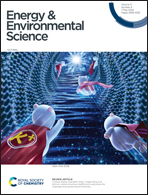Anomalous superionic conductivity in van der Waals lithium thiophosphates triggered by interlayer molecules†
Abstract
Superionic conductors (SICs) are of great importance for substantial applications such as energy storage and conversion, and conductance switching. In contrast to typical SICs which have three-dimensional inter-connected ion diffusion pathways, here, we report a two-dimensional layered LiInP2S6, which theoretically possesses a low ionic conductivity but realistically achieves an anomalous superionic behavior. We demonstrate that this conductor spontaneously absorbs water molecules upon exposure to humid air, resulting in the formation of a hydrated crystal, which triggers a significant increase of room-temperature ionic conductivity as high as 5.3 × 10−3 S cm−1, over 4 orders higher than that of the anhydrous phase. Furthermore, the uptake/release of water molecules is highly reversible without any structural degradation. Structure analysis and theoretical calculations verify that the interlayer molecules would relocate the charge distribution and reduce the ion migration energy barrier (from 0.64 to 0.25 eV) to contribute a three-dimensional continuous pathway for fast Li+ diffusion. We reveal that such a molecule-assisted ionic migration behavior essentially follows a solid-state migration mechanism, in spite of its ionic conductivity up to the liquid electrolyte level, which endows a useful ionic conductivity in hydrated LiInP2S6 even when cooled to −40 °C. Our work can provide new insights for the development of superionic conductors.



 Please wait while we load your content...
Please wait while we load your content...